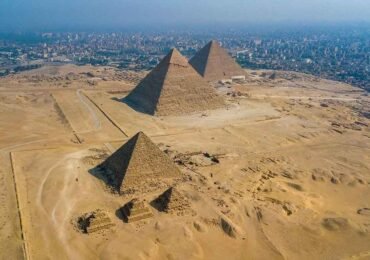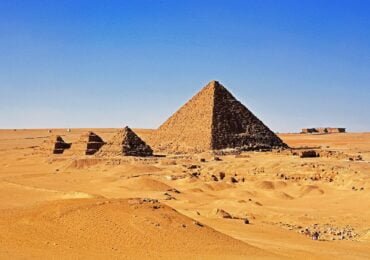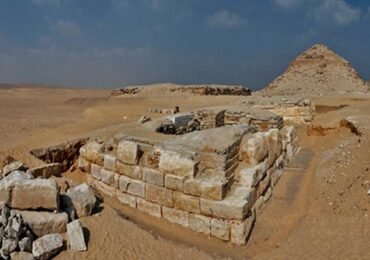Great Pyramid Complex: The Queens’ Pyramids
While the three complexes were under construction and for centuries afterward, Egyptian kings built their monuments elsewhere. They systematically added hundreds of tombs, including queens’ pyramids, to cemeteries surrounding the main pyramids. These tombs served as eternal resting places for the royal family and bureaucratic elite. The cemeteries are divided into fields: East, West, Central, South, and Cemetery GIS.
Khufu’s Queens Pyramids:
Initially focusing on monuments intricately linked to the three main pyramids, Khufu built four small satellite pyramids to the east of the Great Pyramid. Three of these pyramids included mortuary chapels for queens. In 1994, archaeologists uncovered a fourth pyramid (GI-d), and its function is still under debate, but it may have been for the Ka of the king.

Two of the queens pyramid complexes had pits to hold boats for the deceased to use in the afterlife. No trace of the boats has been found and the pits were divided into chambers, perhaps burial chambers, at a later date.
Labels for the queens’ pyramids, arranged from north to south, are GI-a, GI-b, and GI-c. Originally, people ascribed the northernmost pyramid (GI-a) to Queen Meritetes (or Mertitiotes). However, it is now considered either the original or secondary burial site of Queen Hetep-Heres I. Though now little more than a heap of rubble, this pyramid was once estimated to stand 30 meters tall.
Tomb of Queen Hetep-Heres:
Queen Hetep-Heres I was the wife of the King Snefru, founder of Egypt’s 4th Dynasty. She is the mother of Khufu, the builder of the Great Pyramid. In 1925, to the north of GI-a, a narrow shaft was discovered. This led to a single chamber nearly 90 feet underground. Containing beautiful pieces of gilded and inlaid wooden furniture, silver jewelry. A sealed alabaster canopic box and a closed alabaster sarcophagus this was found empty.
The second pyramid (GI-b) is thought to have belonged to Queen Meritetes. Although there is no substantial evidence to support this. The pyramid is in extremely poor condition. The only sign that there was a mortuary chapel are a few markings on the rock. There is evidence of a boat pit associated with the pyramid however, no boat has been found.
Queen Meritetes is thought to have been a daughter of Snefru. A wife of Khufu, possibly the mother of Djedefre who reigned as king between Khufu and Khafre. She was the mother of the Crown Prince Kawab who died before Khufu.
The third and final pyramid (GI-c) is similar to the other two queens pyramids in construction but unlike these is the most complete. The pyramid’s mortuary temple is also the best preserved due to it being reconstructed as a temple of Isis as late as the 26th dynasty.
The pyramid is thought to belong to a queen named Henutsen. Henutsen is known from a stela dated to the 26th Dynasty which was found in the temple of Isis. She is thought to have been a daughter of Snefru, wife of Khufu and mother of Khafre. Debate surround whether this pyramid was actually part of Khufu’s original complex or was built sometime later by Khafre.
Khafre’s Queens Pyramids:
Khafre’s pyramid complex has only one poorly preserved queen’s pyramid. Only the outline of the foundation and a few blocks remain, plus two descending shafts. Some fragments of furniture were found in one of the shafts, plus carnelian beads, animal bones, and covers for pottery vessels. The pyramid was surrounded by its own perimeter wall. This, however, may have been a cult pyramid and not a burial pyramid.

One of Khafre’s wives, Meresankh III was buried nearby in a mastaba tomb (G 7530-7540). Queen Meresankh III was the daughter of Hetep-Heres II and Prince Kawab and a granddaughter of the Egyptian king Khufu. She was the wife of King Khafre. The tomb which is thought to have been originally planned for her mother appears to have been prepared instead after Meresankh’s unexpected death. The tomb contains the best preserved wall reliefs in the eastern Cemetery decorated with scenes of the queen and her royal family, as well as servants, artisans, and funerary priests. The scenes also depict the sort of rich burial goods that would have been placed in Meresankh’s tomb, statues, and fine furniture; boxes containing food, clothing, and jewelry. A black granite sarcophagus decorated with palace facades was found in situ in her burial chamber along with the skeleton on Meresankh.
Menkaure’s Queens Pyramids:
Finally three satellite pyramids, GIII-a & GIII-b thought to be for queens pyramids and GIII-c possibly a satellite pyramid for the Ka of the king. All were built to the south side of Menkaure’s pyramid, running in a line from east to west each with a mudbrick mortuary chapel.

Pyramid GIII-a possibly belonged to Menkaure’s principal wife Khamerernebti II but this is debatable. The internal substructure is T-shaped which suggests it was originally intended has a Ka-Pyramid and later converted. It contained an empty pink granite sarcophagus and had an eastern chapel.
The burial chamber beneath the middle pyramid (GIII-b) contained the bones of a young woman in a pink granite sarcophagus, but no inscriptions remain to identify who this was.
The final pyramid (GIII-c) as mentioned above as probably not for a burial but for the Ka of the king. All three queens pyramids are enclosed as a group by a wall, making them somewhat separate from the pyramid of Menkaure.
Tomb of Khentkawes:
Close to Menkaure’s pyramid complex is the two-stepped hybrid between a royal pyramid and a non-royal mastaba of Khentkawes. Her tomb is known as LG 100 and G 8400 and is located in the Central Field. Khentkawes tomb includes a mortuary temple, antechamber, burial chamber and store room along with a boat pit. Evidence of fragments of an alabaster sarcophagus were found but no signs of a burial. Khentkawes monument has an interesting associated settlement with several streets with houses, magazines, and granaries. This is thought to probably be the homes of the priests and servants of the pyramid complex. It was constructed toward the end of the 4th or beginning of the 5th Dynasty and seems to have been functioning well into the 6th Dynasty.

It is still not certain as to who Khentkawes I was, it is thought that she is probably the daughter of King Menkaure. Whether she was the wife of both king Shepseskaf and king Userkaf (the founder of the Fifth Dynasty) and the mother of king Sahure is debatable.
Tombs of Giza Dignitaries:
Containing some of the most beautiful tomb decorations the high ranking nobles tombs and mastaba’s at Giza are well worth visiting, here are a few of our favourites.
Tomb of KhufuKhaf:
The mastaba tomb of Khufukhaf I (G 7140) is located in the Eastern Cemetery of the complex of the Great Pyramid of king Khufu. The cemetery was reserved for the closest relatives of the king and contains some of the largest mastaba’s on the Giza Plateau.
The mastaba of Khufukhaf I consists of an entrance corridor, a vestibule, a main room or chapel and two burial shafts, one for him, and another for his wife, Neferetkau. The chapel of Khufukhaf I, inside the mastaba, where his funerary cult was conducted, is very well preserved. Many beautiful scenes survive that show him and his wife receiving a wide variety of offerings, which they would both need in the afterlife.
A scene in the chapel depicts him holding his mother’s hand. The hieroglyphic inscriptions beside her reveal that she was the mother of a king, but her name is missing. It is thought that this is Henutsen, one of Khufu’s wives, who is believed to have been buried in one of the three queens’ pyramids next-door. The inscriptions in Khufukhaf I’s mastaba also identify him as a vizier, the highest-ranking official in ancient Egyptian administration.
Eastern Cemetery Tombs:
The tombs of Idu (G7102) and Qar (Meryrenefer) (G7101) are located in the Eastern Cemetery. Idu was the Scribe of the Royal Documents in the presence of the king. He also held the title, “Tenant of the Pyramid of Pepi I” as well as “Inspector of the wab-priests of the Pyramids of Khufu and Khafre during the reign of Pepi I of the 6th Dynasty.
Qar was the “Overseer of the Pyramid Towns of Khufu and Menkaure”, the “Inspector of wab-priests of the Pyramid of Khafre” and “Tenant of the Pyramid of Pepi I during the reign of Pepi II. Both of these tombs provide us with a glimpse into Old Kingdom funerary rituals and have interesting statues.
Mastaba of Seshemnefer IV:
The mastaba of Seshemnefer IV (LG53) is located to the east of Khufu’s pyramid. He lived during the 6th Dynasty and had the titles of “Overseer of the two seat of the House of Life” and “Guardian of all the king’s secrets”. The tomb is on of the largest at Giza and is decorated with both funerary and daily life scenes. The entrance to the tomb is flanked by two statues of the deceased. The tomb has a forecourt and is fronted with pillars. It also contains an inner hall, an outer hall, and finally an offering room. It also has a vestibule, court, and a pillared hall.
Mastaba of Nefermaat II:
To the south of the queens’ pyramids of Khufu the mastaba of Nefermaat II (G7060) can be found. Nefermaat is named as “Son of the King”, “Crowned Prince”, “Overlord of Nekheb“, “Vizier of King Khafre”, and he was a member of the royal family of the 4th Dynasty. The tomb chapel walls are decorated with scenes of the deceased and his wife in front of the scribes and offering bearers. Another scene shows the deceased seated in front of an offering table; under his chair is his favorite dog.
Tomb of Senefrukaef:
Senefrukaef was the son of Nefermaat and probably named after his great-grandfather king Sneferu. Senefrukaef’s tomb (G7070) today consists of a tomb chapel. On the lintel of the doorway there is an offering text and genealogy of Senefrukaef’s family. A limestone sarcophagus was found in the burial shaft, which is now in Cairo Museum. Senefrukaef’s was the ‘Treasurer of the King of Lower Egypt’ and ‘Herdsman of Apis’ during late Dynasty IV to early Dynasty V.
Tomb of Debehen:
The tomb of Debehen is located to the south of Khafre’s causeway. His titles were ‘Lector Priest’ and ‘Overseer of the Divine Places of the Great Palace’ during the Dynasty IV reign of Menkaure. He recorded in his tomb that he was a favorite of the king who gave this official permission for him to construct a tomb near his own pyramid as a gift, which including white limestone from the royal Tura quarries across the river. The tomb is decorated with unpainted reliefs of daily life a depiction of a dwarf.
Tomb of Duaenre:
The Tomb of Duaenre (G5110) is located in the Eastern Cemetery. Duaenre was a son of the pharaoh Khafre, his mother was Meresankh III. He held the title of “‘Vizier of Menkaure’ during the king’s Dynasty IV reign. The tombs entrance leads to offering chapel containing scenes showing Duaenre and attendants bringing offerings and animals. In the burial shaft a uninscribed red granite sarcophagus and lid was found which is now in the Turin Museum.
Mastaba of Iasen:
Mastaba of Iasen (G2196) is found in the western Cemetery includes a surface mastaba, a rock cut chapel and twelve funerary shafts. Iasen was the ‘Tenant of the Royal House’ and ‘Overseer of Priests’ during Dynasty V or VI. The main part of the chapel consists of a large rectangular room with a niche on the western wall containing a standing statue of Iasen, wearing a stiff triangular kilt.
Reliefs in this chamber depict many scenes of offerings and cooking scenes for the funerary banquet. Musicians entertain the deceased, while men fill wine jars in the scene below. There are many colorful scenes of daily life and agriculture in Iasen’s tomb.
You might be interested in one of these Cairo day tours:

